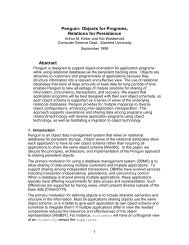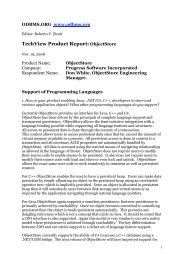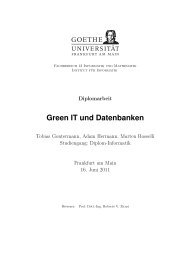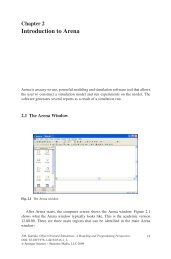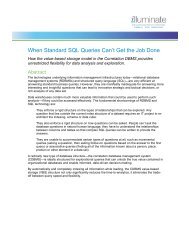Download Chapters 3-6 (.PDF) - ODBMS
Download Chapters 3-6 (.PDF) - ODBMS
Download Chapters 3-6 (.PDF) - ODBMS
You also want an ePaper? Increase the reach of your titles
YUMPU automatically turns print PDFs into web optimized ePapers that Google loves.
3.3. D-3: DIAMETER-PLOT AND GELLING POINT 21<br />
This is one more illustration of how counter-intuitive power laws are. If the degree distribution<br />
of patents/papers was Gaussian or Poisson, then its variance would be small, the average degree<br />
would stabilize toward the distribution mean, and the diameter would grow slowly (O(log N) or<br />
so [80, 195]), but it would not shrink.<br />
3.3 D-3: DIAMETER-PLOT AND GELLING POINT<br />
Studying the effective diameter of the graphs, McGlohon et al. noticed that there is often a point<br />
in time when the diameter spikes [200, 201]. Before that point, the graph typically consists of a<br />
collection of small, disconnected components. This “gelling point” seems to also be the time where<br />
the Giant Connected Component (GCC) forms and “takes off,” in the sense that the vast majority of<br />
nodes belong to it, and, as new nodes appear, they mainly tend to join the GCC, making it even<br />
larger. We shall refer to the rest of the connected components as “NLCC” (non-largest connected<br />
components).<br />
Observation 3.1 Gelling point Real time-evolving graphs exhibit a gelling point, at which the<br />
diameter spikes and (several) disconnected components gel into a giant component.<br />
After the gelling point, the graph obeys the expected rules, such as the densification power law;<br />
its diameter decreases or stabilizes; and, as we said, the giant connected component keeps growing,<br />
absorbing the vast majority of the newcomer nodes.<br />
We show full results for PostNet in Fig. 3.3, including the diameter plot (Fig. 3.3(a)), sizes of<br />
the NLCCs (Fig. 3.3(b)), densification plot (Fig. 3.3(c)), and the sizes of the three largest connected<br />
components in log-linear scale, to observe how the GCC dominates the others (Fig. 3.3(d)). Results<br />
from other networks are similar, and are shown in condensed form for brevity (Fig. 3.4). The left<br />
column shows the diameter plots, and the right column shows the NLCCs, which also present some<br />
surprising regularities, that we describe next.<br />
3.4 D-4: OSCILLATING NLCCS SIZES<br />
After the gelling point, the giant connected component (GCC) keeps on growing. What happens<br />
to the 2nd, 3rd, and other connected components (the NLCCs)?<br />
Do they grow with a smaller rate, following the GCC?<br />
Do they shrink and eventually get absorbed into the GCC?<br />
Or do they stabilize in size?<br />
It turns out that they do a little bit of all three of the above: in fact, they oscillate in size.<br />
Further investigation shows that the oscillation may be explained as follows: new comer nodes<br />
typically link to the GCC; very few of the newcomers link to the 2nd (or 3rd) CC, helping them<br />
to grow slowly; in very rare cases, a newcomer links both to an NLCC, as well as the GCC, thus<br />
leading to the absorption of the NLCC into the GCC. It is exactly at these times that we have a




